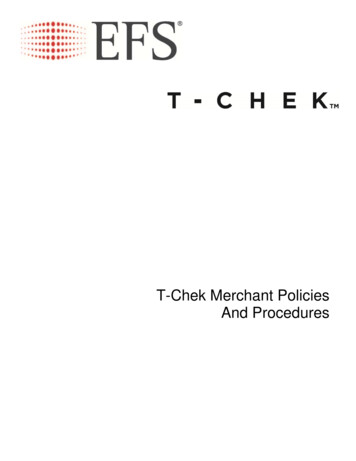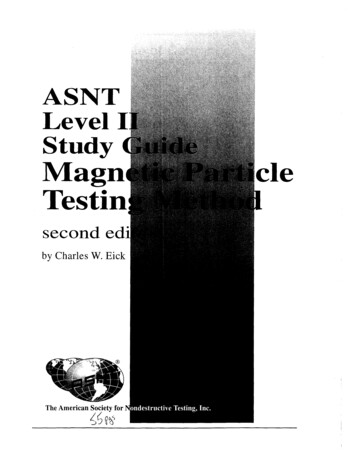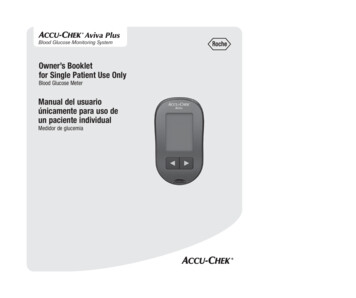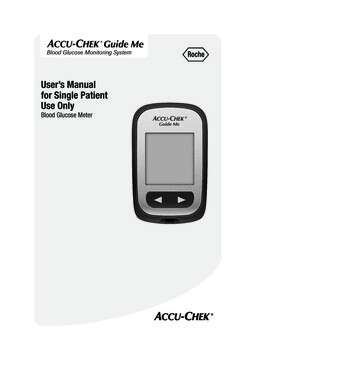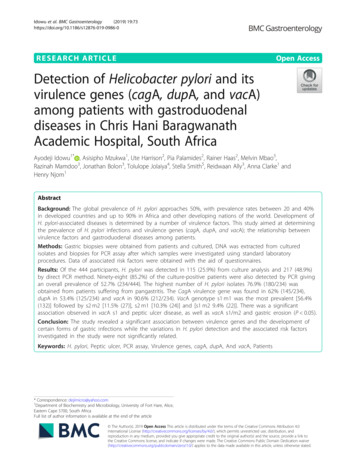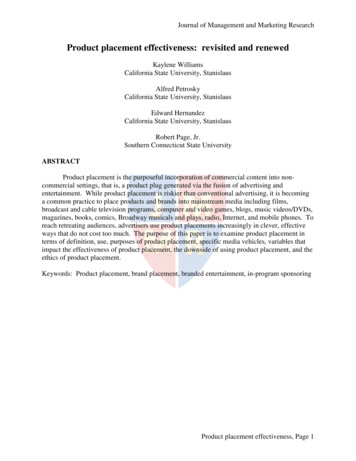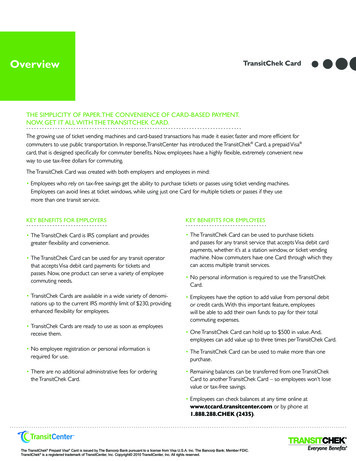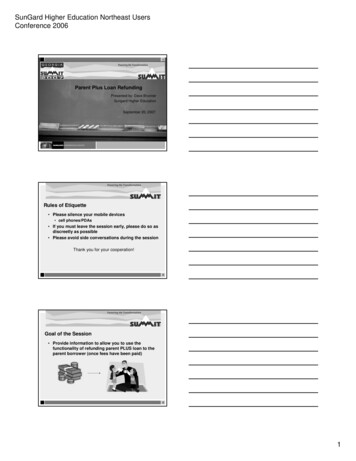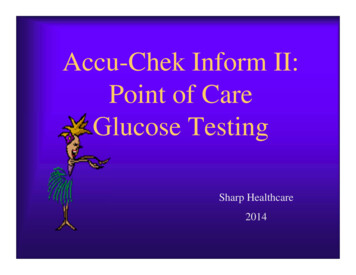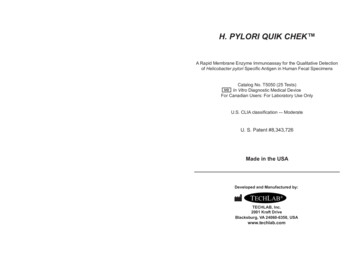
Transcription
12Technical SupportFurther information can be obtained from contacting TECHLAB TechnicalSupport:USPhoneFAXH. PYLORI QUIK CHEK A Rapid Membrane Enzyme Immunoassay for the Qualitative Detectionof Helicobacter pylori Specific Antigen in Human Fecal Specimens 1 800 TECHLAB(540) 953-1664(540) 953-1665Catalog No. T5050 (25 Tests)In Vitro Diagnostic Medical DeviceFor Canadian Users: For Laboratory Use OnlyIVDU.S. CLIA classification -– ModerateU. S. Patent #8,343,726Made in the USADeveloped and Manufactured by:TECHLAB 2018 TECHLAB, Inc. All rights reserved.H. PYLORI QUIK CHEK, the TECHLAB Logo, and TECHLAB are trademarks of TECHLAB,Inc. ProClin is a trademark of Rohm and Haas Company. All other trademarks referencedare trademarks of their respective owners.RMS #92-050-01Issued: 08/2018TECHLAB, Inc.2001 Kraft DriveBlacksburg, VA 24060-6358, USAwww.techlab.com
2H. PYLORI QUIK CHEK INTENDED USEThe TECHLAB H. PYLORI QUIK CHEK test is a rapid membrane enzyme immunoassayfor the qualitative detection of Helicobacter pylori specific antigen in a single use cassette.It is intended for use with human fecal specimens to aid in the diagnosis of H. pyloriinfection and to demonstrate loss of H. pylori antigen following treatment. The test can beused with unpreserved fecal specimens and fecal specimens preserved in transport mediafrom patients suspected of H. pylori infection. Testing of patients to demonstrate loss ofH. pylori antigen following treatment should be performed no sooner than 4 weeks aftercompletion of the treatment regimen. Test results should be taken into consideration by thephysician in conjunction with the patient history and symptoms.Caution: U.S. Federal Law restricts this device to sale by or on the order of aphysician.EXPLANATIONIt is estimated that half of the global population is infected with H. pylori.1 The majority ofthose infected remain asymptomatic and do not require treatment (colonized individuals).A minority of infected individuals develop gastritis, and a fraction of those further developgastric ulcers or gastric cancer.2 The diagnosis of H. pylori infection is endoscopy withbiopsy – the biopsied tissue is tested for the presence of H. pylori by culture, histology,or rapid urease test. Under current guidelines, endoscopy is still recommended for thediagnosis of H. pylori infection in patients with alarm symptoms (e.g. GI bleeding, suddenweight loss, excessive vomiting, anemia), or patients over the age of 55. However, foryounger patients not exhibiting alarm symptoms, non-invasive tests such as the urea breathtest (UBT) or fecal antigen test are recommended for diagnosis of H. pylori infection.3,4Following completion of a treatment regimen of antibiotics and a proton pump inhibitor(PPI), it is recommended that patients be tested to verify eradication of H. pylori infection.5Serum antibody tests are also available, but these are unable to distinguish between pastand current infection. By detecting antigen present in fecal specimens, the H. PYLORIQUIK CHEK test allows for the non-invasive detection of H. pylori when endoscopy is notrequired.PRINCIPLE OF THE TESTThe H. PYLORI QUIK CHEK test utilizes antibodies specific for H. pylori antigen. TheMembrane Device contains a Reaction Window with two vertical lines of immobilizedantibodies. The test line (“T”) contains antibodies specific for H. pylori antigen. The controlline (“C”) contains antibodies to horseradish peroxidase (HRP). The Conjugate consistsof antibodies to H. pylori antigen coupled to horseradish peroxidase. To perform thetest, the sample is added to a tube containing a mixture of Diluent and Conjugate. Thediluted sample-conjugate mixture is added to the Sample Well and the device is allowedto incubate at room temperature for 15 minutes. During the incubation, any H. pyloriantigen in the sample binds to the antibody-peroxidase conjugate. The antigen-antibodyperoxidase complexes migrate through a filter pad to a membrane where they are capturedby the immobilized anti-H. pylori antigen antibodies in the test line. The Reaction Windowis subsequently washed with Wash Buffer, followed by the addition of Substrate. After a10-minute incubation period, the Reaction Window is examined visually for the appearanceof vertical blue lines on the “C” and “T” sides of the Reaction Window. A blue line on the “T”side of the Reaction Window indicates a positive result. A positive “C” reaction, indicatedby a vertical blue line on the “C” side of the Reaction Window, confirms that the sampleand reagents were added correctly, the reagents were active at the time of performingthe assay, and that the sample migrated properly through the Membrane Device. It alsoconfirms the reactivity of the other reagents associated with the assay.11REFERENCES1. Hunt RH, Xiao SD, Megraud F, Leon-Barua R, Bazzoli F, van der Merwe S, VazCoelho LG, Fock M, Fedail S, Cohen H, Malfertheiner P, Vakil N, Hamid S, GohKL, Wong BC, Krabshuis J, Le Mair A; World Gastroenterology Organization. 2011.Helicobacter pylori in developing countries. World Gastroenterology OrganisationGlobal Guideline. J Gastrointestin Liver Dis. 20:299-304.2. Wroblewski LE, Peek RM Jr., Wilson KT. 2010. Helicobacter pylori and gastric cancer:factors that modulate disease risk. Clin Microbiol Rev. 23:713-739.3. Talley NJ, Vakil N. 2005. Practice Parameters Committee of the American College ofGastroenterology. Guidelines for the management of dyspepsia. Am J Gastroenterol.100:2324-37.4. Talley NJ. 2005. American Gastroenterological Association medical position statement:evaluation of dyspepsia. Gastroenterology. 129:1753-1755.5. Chey WD, Wong BC, Practice Parameters Committee of the American College ofGastroenterology. 2007. American College of Gastroenterology guideline on themanagement of Helicobacter pylori infection. Am J Gastroenterol. 102:1808-18256. Moayyedi P, Axon AT, Feltbower R, Duffett S, Crocombe W, Braunholtz D, RichardsID, Dowell AC, Forman D; Leeds HELP Study Group. 2002 Relation of adult lifestyleand socioeconomic factors to the prevalence of Helicobacter pylori infection. Int JEpidemiol. 31:624-631.7. Everhart JE, Kruszon-Moran D, Perez-Perez GI, Tralka TS, McQuillan G. 2000.Seroprevalence and ethnic differences in Helicobacter pylori infection among adults inthe United States. J Infect Dis. 181:1359-1363.8. Testerman TL, Morris J. 2014. Beyond the stomach: An updated view of Helicobacterpylori pathogenesis, diagnosis, and treatment. World J Gastroenterol. 20: 12781–12808.9. Kim SY, Choi DJ, Chung J. 2015. Antibiotic treatment for Helicobacter pylori: Is theend coming? World J Gastrointest Pharmacol Ther. 6:183–198.10. Chen H, Dang Y, Zhou X, Liu B, Liu S, Zhang G. 2016. Tailored Therapy VersusEmpiric Chosen Treatment for Helicobacter pylori Eradication: A Meta-Analysis.Medicine (Baltimore). 95: e2750.
10INCLUSIVITY STUDYThe following strains, which include isolates representing described H. pylori populations,were tested for reactivity with the H. PYLORI QUIK CHEK test. All strains testedgenerated a positive result.ATCC 700392ATCC 43526ATCC 700824JP26ATCC 43504ATCC 43579INTERFERING SUBSTANCES (U.S. FORMULATION)The following substances had no effect on positive or negative H. PYLORI QUIK CHEK test results analyzed at the concentrations indicated:Barium sulfate (5% w/v), Benzalkonium Chloride (1% w/v), Ciprofloxacin (0.25% w/v),Ethanol (1% w/v), Hog gastric mucin (3.5% w/v), Human blood (40% v/v), Hydrocortisone(1% w/v), Imodium (5% v/v), Kaopectate (5% v/v), Leukocytes (0.05% v/v), Maalox Advanced (5% v/v), Mesalazine (10% w/v), Metronidazole (0.25% w/v), MiraLax (3350PEG)(7% w/v), Mineral Oil (10% w/v), Mylanta (4.2 mg/mL), Naproxen Sodium (5%w/v), Nonoxynol-9 (1% w/v), Nystatin (1% w/v), Palmitic Acid/Fecal Fat (40% w/v), PeptoBismol (5% v/v), Phenylephrine (1% w/v), Prilosec OTC (5 µg/mL), Sennosides (1% w/v),Simethicone (10% w/v), Stearic Acid/Fecal Fat (40% w/v), Tagamet (5 µg/mL), TUMS (50µg/mL), Human Urine (5% v/v), and Vancomycin (0.25% w/v).ANALYTICAL SENSITIVITYThe Limit of Detection (LoD) for the H. PYLORI QUIK CHEK test was established at16.08 ng/mL in fecal matrix (0.24 ng/test) for Helicobacter pylori antigen using cell lysateantigen prepared from H. pylori strain ATCC 43526. For specimens in Protocol CaryBlair media, the LoD was established at 13.01 ng/mL (0.20 ng/test). For specimens inProtocol C&S media, the LoD was established at 19.96 ng/mL (0.31 ng/test).FRESH VERSUS FROZEN SAMPLESThe effect of long term frozen specimen storage on antigen stability was evaluated. For theanalysis, a total of 32 fecal specimens was tested with the H. PYLORI QUIK CHEK test.The fecal specimens consisted of 2 negative fecal samples, 5 high negative fecal samples,10 low positive fecal samples, and 15 positive fecal samples covering the range of thetest (50 ng/mL – 1200 ng/mL). Samples were prepared and stored -10 C and -70 Cand tested at 0, 5, 10, and 14 days. No conversion of positive-to-negative or negative-topositive was observed in any of the samples at the specified time points.PROZONETo ensure that a high concentration of H. pylori antigen does not interfere with a positivereaction in the H. PYLORI QUIK CHEK test, high positive samples were prepared byspiking a negative fecal pool at concentrations up to 10 times the highest concentration ofantigen observed in a positive clinical specimen. A total of 5 different dilutions of H. pyloriantigen was prepared and tested in triplicate. The results demonstrated that there wasno overall prozone effect, that elevated levels of antigen did not affect the detection of theantigen.MATERIALS PROVIDEDMEM DEVMembrane Devices – 25, each pouch contains 1 deviceConjugate (2.5 mL) – Antibody specific for H. pylori antigen coupled toCONJ ENZhorseradish peroxidase in a buffered protein solution (contains 0.05%ProClin 300)*DIL SPEDiluent (22 mL) – Buffered protein solution with black graduated dropperassembly (contains 0.05% ProClin 300)*CONTROL Positive Control (2 mL) – H. pylori antigen in a buffered protein solution(contains 0.05% ProClin 300)*SUBS REAGSubstrate (3.5 mL) – Solution containing tetramethylbenzidineWASHBUF 20X Wash Buffer (12 mL) – Buffered solution with white graduated dropperassembly (contains 0.05% ProClin 300)*Disposable plastic transfer pipettes (50) – Graduated at 25 µL, 100 µL, 200 µL, 300 µL,400 µL and 500 µLWooden applicator sticks (50)3*(contains 0.05% ProClin 300)Signal Word: WarningH317: May cause an allergic skin reactionP261, P272, P280, P302, P352, P333, P313, P321, P362, P364, P501MATERIALS AND EQUIPMENT REQUIRED BUT NOT PROVIDEDSmall test tubes (e.g., plastic 2 mL conical microcentrifuge tubes)Vortex mixerDisposable gloves TimerSHELF LIFE AND STORAGEThe expiration date of the kit is given on the kit box label. Expiration dates for eachcomponent are listed on the individual labels. Store the kit between 2 C and 8 C. Returnthe kit to the refrigerator as soon as possible after use.PRECAUTIONS1. Rx Only – Prescription Only2. Each component in the kit should be inspected for any signs of leakage. Upon arrival,inspect the kit to ensure that components are not frozen or warm to the touch due toimproper shipping conditions.3. The Substrate reagent should be colorless. If the Substrate reagent changes to a darkblue/violet color, discard and call Technical Services for a replacement.4. Reagents from different kits should not be mixed or interchanged. Do not use a kitpast the expiration date.5. Caps, tips and dropper assemblies are color-coded; do NOT mix or interchange!6. Bring all components to room temperature before use to ensure proper kit reactivity.Remove the reagents from the foam insert to reduce the time needed to warm to roomtemperature.7. Do not freeze the reagents. The kit should be stored between 2 C and 8 C.8. The pouch containing the Membrane Device should be at room temperature beforeopening. Keep the Membrane Devices dry before use.9. Hold reagent bottles vertically to dispense reagents to ensure consistent drop size andcorrect volume.10. Microbial contamination of reagents may decrease the accuracy of the assay. Avoidmicrobial contamination of reagents by using sterile disposable pipettes if removingaliquots from reagent bottles.11. Membrane Devices cannot be reused.12. The test has been optimized for sensitivity and specificity. Alterations of the specifiedprocedure and/or test conditions may affect the sensitivity and specificity of the test.Do not deviate from the specified procedure.
413. The validity of the test results using the H. PYLORI QUIK CHEK test is dependentupon the proper reaction of the internal and external controls. See the Quality Controlsection.14. Fecal specimens and used membrane devices may contain potentially infectiousagents and should be handled at “Biosafety Level 2” as recommended in the CDC/NIHManual “Biosafety in Microbiological and Biomedical Laboratories.” Wear disposablegloves when performing the test.15. Reagents contain 0.05% ProClin 300 as a preservative. Although the concentrationis low, ProClin 300 is known to be harmful. If skin irritation or rash occurs, getmedical advice/attention. Take off contaminated clothing and wash it before reuse.Handle reagents according to existing regulations for laboratory safety and goodlaboratory practice. Safety Data Sheets for this product are available upon request,contact technical support.16. Follow your national, regional, and local ordinances accordingly for waste disposalregulations. Do not place in trash, dispose of as hazardous waste.COLLECTION, HANDLING, AND STORAGE OF FECAL SPECIMENSAcceptable SampleTypeDo Not UseFresh Fecal SpecimensFecal Specimens in Formalin-based fixative (e.g., sodiumacetate formalin, 10% formalin)Frozen Fecal SpecimensFecal Specimens in alcohol-based fixative (e.g., polyvinylalcohol)Specimens in TransportMedia (Cary Blair, C&S)Concentrated Fecal SpecimensStorage ConditionRecommendedStorage TimeFresh Unpreserved Samples and Samples in Cary Blair orC&S Transport Media Stored between 2 C and 8 C96 hoursFresh Unpreserved Samples and Samples in Cary Blair orC&S Transport Media Stored between 20 C and 25 C96 hoursFrozen Unpreserved Samples Stored at -10 C14 days1.2.3.4.Use standard in-house collection and handling procedures for fecal specimens.Collect fecal specimens in clean, leak-proof containers.Fecal specimens that are stored frozen may be thawed up to 2 times. If using frozenspecimens, thaw at room temperature.Do not store fecal specimens in the Diluent.Do not allow the fecal specimens to remain in the Diluent/Conjugate mixture for 2 hours.TEST PROCEDURE1. Be attentive to the total assay time when testing more than one fecal specimen.2. Bring all reagents and devices to room temperature before use. Remove the reagentsfrom the foam insert to reduce the time needed to warm to room temperature.3. Set up and label one small test tube for each specimen and optional externalcontrol.4. Using the black graduated dropper assembly, add 750 µL of Diluent to eachtube for fresh and frozen specimens, and external controls. For specimens inTransport Media (Cary Blair, C&S), add 650 µL of Diluent to each tube.9FDA ClearedCommercial ELISAPositiveFDA ClearedCommercial ELISANegativeH. PYLORI QUIK CHEK Positive933*H. PYLORI QUIK CHEK Negative1**103N 20095% ConfidenceLimitsPercent Positive Agreement98.9%94.2% - 99.8%Percent Negative Agreement97.2%92.0% - 99.0%* H. pylori DNA was amplified from the samples with PCR** No H. pylori DNA was amplified from the sample with PCRREPRODUCIBILITYThe reproducibility of the H. PYLORI QUIK CHEK test was determined using 8 fecalspecimens that were coded to prevent identification during testing. Testing was performedat 2 independent laboratories and on-site at TECHLAB, Inc. The samples were testedin triplicate twice a day over a 5-day period by multiple technicians at each site using 2different kit lots. The results were as expected among the different locations, and exhibitedan overall percent agreement of 100%.CROSS REACTIVITYThe H. PYLORI QUIK CHEK test was evaluated for cross-reactivity with commonintestinal organisms and viruses listed below. None of the organisms or viruses were shownto interfere with the performance of the H. PYLORI QUIK CHEK test.Acinetobacter baumanniiBacillus cereusBacillus subtilisBorrelia burgdorferiCampylobacter coliCampylobacter fetusCampylobacter helveticusCampylobacter hyointestinalisCampylobacter jejuniCampylobacter lariCampylobacter upsaliensisCandida albicansClostridium bifermentansClostridium difficileClostridium perfringensEdwardsiella tardaEnterobacter cloacaeEnterococcus faecalisEscherichia coliEscherichia coli EIECEscherichia coli EPECEscherichia coli ETECEscherichia coli O157:H7 (non-toxigenic)Escherichia coli O157:H7 (toxigenic)Haemophilus influenzaeLactobacillus acidophilusListeria monocytogenesPeptostreptococcus anaerobiusPorphyromonas asaccharolyticaPrevotella melaninogenicaProteus vulgarisPseudomonas aeruginosaPseudomonas fluorescensSalmonella typhimuriumStaphylococcus aureusStaphylococcus aureus (Cowan’s)Streptococcus agalactiaeYersinia enterocoliticaAdenovirus Types 2, 40Human CoronavirusCoxsackievirus B1, B2, B3, B6Echovirus 9, 22Enterovirus 70Human Rotavirus
85PERFORMANCE CHARACTERISTICSThe performance of the H. PYLORI QUIK CHEK test was evaluated at 6 independentsites. Patients were recruited that were undergoing endoscopy as part of routine care. Acomposite reference method (CRM) comparison was used in the evaluation consisting ofrapid urease and histology of the biopsy samples. The following table shows a summaryof the clinical performance data. The results of the study show that the H. PYLORI QUIKCHEK test exhibited sensitivity of 97.0% and specificity 100% with CRM biopsy results.Age and Gender DistributionAge and gender information was available for 122 patients. The ages ranged from 19 to 82years. Of the 122 patients tested, 68% were female and 32% were male. No difference intest performance was observed based on patient age or gender.Initial Diagnosis H. PYLORI QUIK CHEK test versus Composite Reference Method(CRM)CRM PositiveCRM NegativeH. PYLORI QUIK CHEK PositiveN 122320H. PYLORI QUIK CHEK Negative1*89Sensitivity97.0%84.7% - 99.5%Specificity100.0%95.9% - 100.0%* Additional testing with an FDA cleared H. pylori stool antigen test provided an antigen negative result.Post-TherapyFor Eradication (post-therapy), there were 9 samples from patients being tested posttherapy. The results show that the H. PYLORI QUIK CHEK test exhibited a sensitivity of100% with the composite reference method.CRM PositiveCRM NegativeH. PYLORI QUIK CHEK Positive90H. PYLORI QUIK CHEK Negative0095% ConfidenceLimitsSensitivityVolume of DiluentFresh Fecal Specimens750 µL (2nd graduation from tip)Frozen Fecal Specimens (frozenundiluted)750 µL (2nd graduation from tip)External Controls (positive andnegative)750 µL (2nd graduation from tip)Specimens in Transport Media(Cary Blair, C&S)650 µL (1st graduation from tip)5.6.750650µLAdd one drop of Conjugate (red capped bottle) to each tube. Gently mix theConjugate in the bottle by inverting several times prior to addition. Hold the dropperbottle vertically to ensure proper drop size. The Diluent and Conjugate should beadded to all tubes prior to adding the specimens.Obtain one disposable plastic transfer pipette (supplied with the kit) for each sample.Graduated Transfer Pipette:95% ConfidenceLimitsN 9Sample Type100.0%70.1% - 100.0%Retrospective Sample StudyA supplemental retrospective sample study was performed comparing the H. PYLORIQUIK CHEK test to an FDA cleared commercial ELISA. For this study, 200 samples (96positive and 104 negative by the commercial ELISA) were evaluated. There was 98.9%Positive Agreement and 97.2% Negative Agreement of results between the assays.500 µL 400 µL 300 µL 200 µL 100 µL25 µLFor Liquid/Semi-Solid Specimens - Mix specimen thoroughly. Using a transfer pipet,add 25 µL of specimen to the Diluent/Conjugate mixture in the tube.For Formed/Solid specimens –Mix specimen thoroughly using a wooden applicatorstick and transfer a small portion (approximately 2 mm diameter, the equivalent of25 µL) of the specimen into the Diluent/Conjugate mixture. Emulsify the specimenusing the applicator stick.For specimens in transport media (Cary Blair or C&S) - Using a transfer pipette,transfer 100 µL of specimen into the Diluent/Conjugate mixture.Note: Transferring too little sample, or failure to mix and completely suspend thesample in the Diluent/Conjugate mixture, may result in a false-negative test result. Theaddition of too much sample may cause invalid results due to restricted flow.8. Optional External Controls:External Positive Control - add one drop of Positive Control (gray-capped bottle) to theappropriate test tube.External Negative Control - add 25 µL Diluent to the appropriate test tube.9. For all test and control samples, close the tubes and mix thoroughly using a vortexmixer or by inverting the tube several times. Samples or controls diluted in theDiluent/Conjugate mixture may be incubated at room temperature up to 2 hours priorto addition to the Membrane Device.10. Open one room temperature Membrane Device pouch for each diluted specimen andexternal control (as necessary). Label each device appropriately and orient it on a flatsurface so the “H. PYLORI QUIK CHEK” print is at the bottom of the device, and thesmall Sample Well located in the top right corner of the device.7.Membrane DeviceReaction WindowSample WellCTH PYLORI QUIK CHEK
6711. Make sure that each diluted sample is thoroughly mixed (See Step 9) before addingto the Membrane Device. Using a new transfer pipette, transfer 500 µL (topmostgraduation) from each tube into the Sample Well (smaller hole in the top rightcorner of the device) of a Membrane Device. When adding the sample into theSample Well, make sure that the tip of the transfer pipette is inside the Sample Wellhole and angled towards the Reaction Window. Expel the diluted sample onto thewicking pad inside the Membrane Device.12. Incubate the device at room temperature for 15 minutes – the sample will wickthrough the device and a wet area will spread across the Reaction Window. The15-minute incubation step begins after the last diluted sample-conjugate mixture hasbeen transferred to the last Membrane Device.NOTE FOR SAMPLES THAT FAIL TO MIGRATE:Occasionally, a diluted sample fails to migrate properly and the Reaction Window doesnot fully wet. If the Reaction Window does not appear to be completely wet within5 minutes of adding the sample to the Sample Well, then add 100 µL (4 drops) ofDiluent to the Sample Well and wait an additional 5 minutes (for a total of 20 minutes).Continue with the next step of the Test Procedure.13. After the incubation, add 300 µL of Wash Buffer to the central Reaction Windowusing the graduated white dropper assembly). Allow the Wash Buffer to beabsorbed completely.14. Add 2 drops of Substrate (white-capped bottle) to the central Reaction Window.15. Incubate 10 minutes at room temperature. Read visually and record results after theincubation.INTERPRETATION OF RESULTSC1.2.3.4.5.TCTCTCTH PYLORI QUIK CHEKH PYLORI QUIK CHEKH PYLORI QUIK CHEKH PYLORI QUIK CHEKPositive ResultNegative ResultInvalid ResultInvalid ResultInterpretation of the test is most reliable when the device is read immediately at theend of the reaction, in a well-lit area, and from directly over the device at a normalworking distance.Positive Result: Two vertical blue lines are visible, the control line on the “C” (left)side of the Reaction Window and the test line on the “T” (right) side of the ReactionWindow. The lines may appear faint to dark in intensity - any line on the “T” side isconsidered positive. Do not interpret membrane discoloration as a positive result. Apositive result indicates the presence of H. pylori antigen, and that there is a properlyreactive positive control line.Negative Result: A single vertical blue line is visible on the “C” (left) side of theReaction Window and no test line is visible on the “T” (right) side of the ReactionWindow. A negative result indicates that H. pylori antigen is either absent in thesample or is below the detection limit of the test, and that there is a properly reactivepositive control line.Invalid Result: A single line is visible on the “T” side of the Reaction Window, orno lines are visible in the Reaction Window. The test is invalid if a control line is notpresent at the completion of the test reaction.A positive result in the H. PYLORI QUIK CHEK test confirms the presence of H.pylori antigen in the sample; a negative result indicates the absence of antigen orinsufficient levels of antigen for detection.QUALITY CONTROLThe validity of the test results using the H. PYLORI QUIK CHEK test is dependent uponthe proper reaction of the internal and external controls. If correct control results are notobserved, contact Technical Support.Internal: A vertical blue control line must be visible on the “C” (Control) side of theReaction Window on every Membrane Device that is tested. The appearance of the bluecontrol line confirms that the sample and reagents were added correctly, that the samplemigrated properly through the Membrane Device. It also confirms the reactivity of the otherreagents associated with the assay. A uniform background in the result area is consideredan internal negative control.External: The reactivity of the H. PYLORI QUIK CHEK test should be verified on receiptusing the Positive Control and negative control (Diluent). The Positive Control confirmsthe reactivity of the other reagents associated with the assay, and is not intended to ensureprecision at the analytical assay cut-off. Additional tests can be performed with the controlsto meet the requirements of local, state and/or federal regulations and/or accreditingorganizations.LIMITATIONS OF THE H. PYLORI QUIK CHEK TEST1. The H. PYLORI QUIK CHEK test is used to detect H. pylori antigen in fecalspecimens. The test confirms the presence of H. pylori antigen in the sample, and thisinformation should be taken under consideration by the physician in light of the clinicalhistory and physical examination of the patient.2. A negative test result does not preclude the possibility of the presence of H. pyloriantigen in the specimen which may occur if the level of antigen is below the detectionlimit of the test.3. False negative results may occur if a patient has used antibiotics, proton pumpinhibitors (PPIs) or bismuth compounds in the 14 days prior to fecal sample collection,as these medications are known to inhibit H. pylori. In these cases, a new fecalsample should be collected and tested 14 days after treatment has stopped. Positiveresults from patients that have used antibiotics, PPIs, or bismuth compounds in the 14days prior to fecal sample collection are still considered accurate.4. Transferring too little sample, or failure to mix and completely suspend the sample inthe Diluent/Conjugate mixture, may result in a false-negative test result. The additionof too much sample may cause invalid results due to restricted flow.5. The H. PYLORI QUIK CHEK test is qualitative. The intensity of the color should notbe interpreted quantitatively.6. No data exists on the effects of colonic washes, barium enemas, laxatives, or bowelpreparations on the performance of the H. PYLORI QUIK CHEK test. Theseprocedures can result in extensive dilution or the presence of additives that may affecttest performance.EXPECTED VALUESThe H. PYLORI QUIK CHEK test detects the presence of Helicobacter pylori antigen inhuman fecal samples. H. pylori infection is a global phenomenon with reported prevalencerates in adults ranging from 20% to 95%.1 In addition to geographical location, factors suchas age, ethnicity, and socioeconomic status also affect the prevalence rate.6,7 H. pylori ispurportedly the cause of 70%-85% of gastric ulcers and 90%-95% of duodenal ulcers.8Historically, treatment regimens to eradicate H. pylori infection reported success ratesranging from 76%-94%, but the efficacy of standard treatment regimens has declined dueto factors such as the increased prevalence of antibiotic resistant H. pylori strains.9 Theeffectiveness of eradication therapy can improve significantly when a tailored regimen isprescribed.10
6711. Make sure that each diluted sample is thoroughly mixed (See Step 9) before addingto the Membrane Device. Using a new transfer pipette, transfer 500 µL (topmostgraduation) from each tube into the Sample Well (smaller hole in the top rightcorner of the device) of a Membrane Device. When adding the sample into theSample Well, make sure that the tip of the transfer pipette is inside the Sample Wellhole and angled towards the Reaction Window. Expel the diluted sample onto thewicking pad inside the Membrane Device.12. Incubate the device at room temperature for 15 minutes – the sample will wickthrough the device and a wet area will spread across the Reaction Window. The15-minute incubation step begins after the last diluted sample-conjugate mixture hasbeen transferred to the last Membrane Device.NOTE FOR SAMPLES THAT FAIL TO MIGRATE:Occasionally, a diluted sample fails to migrate properly and the Reaction Window doesnot fully wet. If the Reaction Window does not appear to be completely wet within5 minutes of adding the sample to the Sample Well, then add 100 µL (4 drops) ofDiluent to the Sample Well and wait an additional 5 minutes (for a total of 20 minutes).Continue with the next step of the Test Procedure.13. After the incubation, add 300 µL of Wash Buffer to the central Reaction Windowusing the graduated white dropper assembly). Allow the Wash Buffer to beabsorbed completely.14. Add 2 drops of Substrate (white-capped bottle) to the central Reaction Window.15. Incubate 10 minutes at room temperature. Read visually and re
H. PYLORI QUIK CHEK INTENDED USE The TECHLAB H. PYLORI QUIK CHEK test is a rapid membrane enzyme immunoassay for the qualitative detection of Helicobacter pylori specific antigen in a single use cassette. It is intended for use with human fecal specimens to aid in the diagnosis of H. pylori infection and to demonstrate loss of H. pylori antigen following treatment.
